Understanding Bird Stands and Perches: A Guide
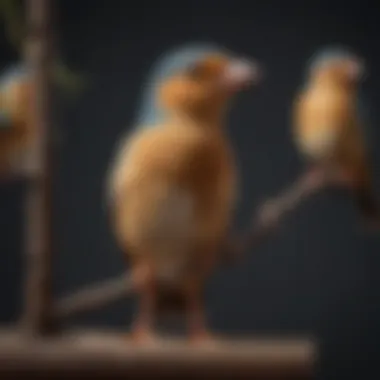
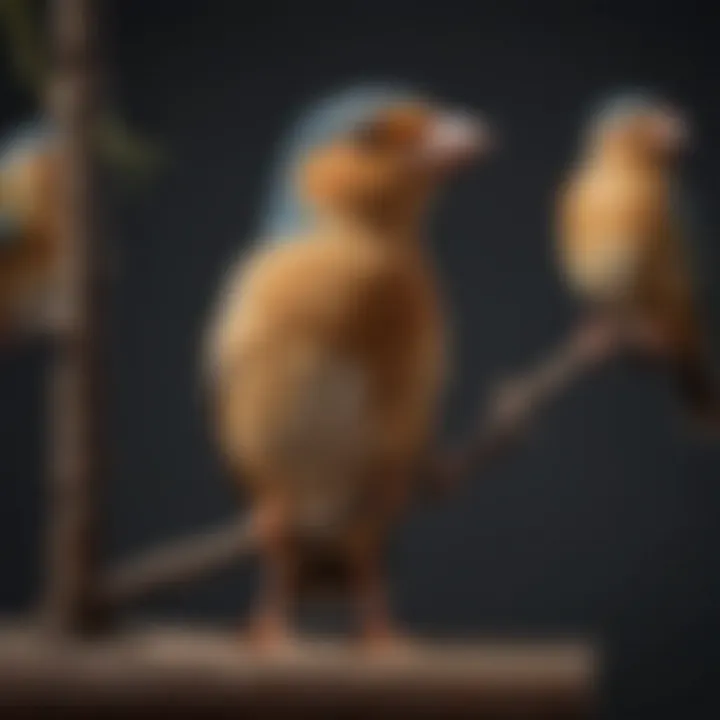
Intro
Bird stands and perches are more than simple accessories; they form the backbone of a bird's environment. Understanding these elements is critical for bird owners striving for both the physical and mental well-being of their avian companions. Bird stands and perches allow birds to engage in natural behaviors, promote health, and provide comfort.
In this guide, we will explore various aspects of bird stands and perches including their importance, types available, favorable materials, and maintenance practices that ensure their longevity. By optimizing these elements, you can create a space that nurtures your pet's happiness and health.
Understanding Your Pet
Pet Behavior Basics
Birds have unique behaviors that reflect their wild ancestry. They are social animals requiring interaction, mental stimulation, and exercise. A well-designed stand or perch serves as a focal point for these activities. Understanding basic behavior is essential for choosing the right accessories for your bird.
Common Breed Characteristics
Different breeds exhibit distinct preferences and needs. For example, budgies are playful and enjoy climbing, while cockatiels may prefer lower perches for comfort. Recognizing these traits helps you select the right bird perches which cater to their natural tendencies.
Species-Specific Needs
Each bird species has specific requirements for comfort and well-being. Larger birds like parrots need sturdy, wide perches, while canaries may thrive on smaller, more delicate options. Always consider your bird's size, species, and individual preferences when selecting perches.
Pet Care and Maintenance
Feeding Guidelines
Though feeding may not directly relate to perches, a well-fed bird will be more active and likely to use its perches effectively. A balanced diet contributes to overall health, making regular feeding practices essential.
Grooming Essentials
Regular grooming is important for a bird’s comfort. Beaks and nails may need trimming to prevent injury while perched. Keeping these aspects in check ensures that your bird remains comfortable as it interacts with its environment.
Hygiene Practices
Maintaining hygiene around your bird’s perches is critical. Regular cleaning prevents the buildup of bacteria. Use safe cleaners and check perches regularly for signs of wear or contamination.
Training and Development
Basic Commands and Skills
Introducing your bird to perches can involve training them to use different levels or types. Simple commands, such as "step up", can encourage them to explore their stand or perch area.
Behavioral Training Techniques
Positive reinforcement works well for birds. Rewarding them when they use their perches helps them associate these spaces with a positive experience.
Addressing Common Behavior Issues
If a bird refuses to use its perch, it may indicate discomfort or a preference for a different location. Observing their behavior and adjusting accordingly can mitigate common issues.
Health and Wellness
Routine Vet Check-ups
Regular veterinary visits are vital for ensuring your bird’s overall health. Your vet can provide guidance on perch types that promote proper posture and comfort.
Vaccination Needs
Birds require vaccinations against common diseases. Health impacts a bird’s behavior and use of perches. Ensuring your pet is healthy allows them to engage fully in their environment.
Recognizing Signs of Illness
Observing your bird's habits on its perch can indicate health issues. Lethargy, changes in eating behavior, or avoidance of perches often point to underlying problems. Immediate attention is crucial.
Enrichment and Activities
Indoor vs. Outdoor Activities
Both indoor and outdoor activities should be considered. Outdoor environments may offer natural stimuli that enhance perch use, while secure indoor setups can provide safe spaces for exploration.
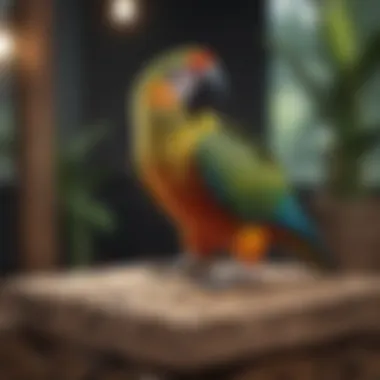
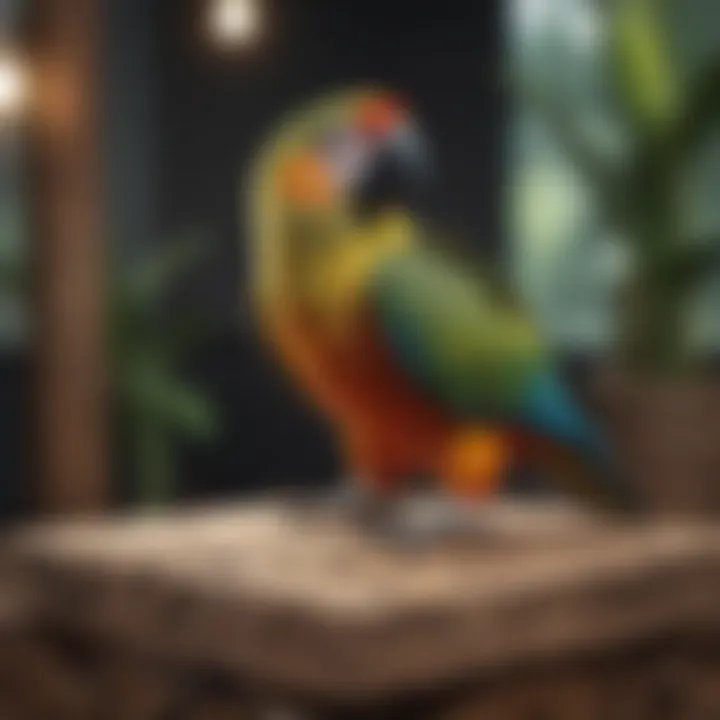
Interactive Toys and Games
Including toys near perches promotes activity. Birds enjoy engaging with objects that stimulate their minds and bodies. Consider puzzle toys, swings, or attaching toys to stands for added interest.
Socialization Opportunities
Birds are social creatures. Offering opportunities for interaction, whether with other birds or their human family members, enhances their enjoyment of perching. Social interaction can reduce stress and foster well-being.
This comprehensive guide highlights the essential role of bird stands and perches in creating a fulfilling environment for your pet birds.
Prelude to Bird Stands and Perches
Understanding bird stands and perches serves a critical role in enriching the lives of avian companions. These accessories are not merely decorative; they are vital to the physical and mental health of birds. By allowing birds to engage with their environment, perches and stands facilitate natural behaviors. This article will illuminate the various types of bird stands and perches available and help bird owners make informed decisions about each.
Definition and Purpose
Bird stands and perches are structures designed for birds to rest, play, and engage in social activities, replicating natural settings where birds would perch on branches or other surfaces. Their primary purpose is to provide a safe and comfortable space for birds to stay in while not flying. Additionally, they are critical for maintaining a bird's mental health by providing a platform for climbing, exploring, and playing. Species-specific designs account for the differing needs of various types of birds, ensuring safety and comfort.
Why Birds Need Perches
Perches are essential for several reasons:
- Physical Comfort: Properly designed perches offer birds a place to rest their feet, reducing the strain caused by standing on unsuitable surfaces.
- Social Interaction: Birds are social animals. Having multiple perches encourages interaction, which can reduce stress and prevent loneliness.
- Exercise and Engagement: Climbing and jumping enhance muscle strength and coordination. Perches facilitate exercise which is crucial for healthy birds.
- Mental Stimulation: Varied perching heights and materials can stimulate a bird's curiosity and motivation to explore its environment.
"Perches are not just an accessory; they are a sanctuary for your bird's well-being."
The careful selection of perches, considering size, material, and placement, leads to a more fulfilling life for birds. Understanding these elements is key to creating an enriched living space.
Types of Bird Stands
Understanding the different types of bird stands is significant for every bird owner. These stands serve multiple purposes, enhancing the overall well-being of the bird. A well-selected bird stand not only promotes comfort and relaxation but also facilitates activities related to feeding, playing, and exercising. Choosing the right bird stand depends on various factors such as the bird's species, personality, and routine. This comprehensive overview will highlight the types of bird stands, each designed to meet specific needs in a bird's life.
Playstands
Playstands are specifically designed for the purpose of entertainment and activity. These stands often feature multiple perches and toys, providing an engaging environment for a bird. The main benefits of using a playstand include:
- Variety of Activities: Birds can play, climb, and explore, which keeps them physically active.
- Social Interaction: Having a playstand encourages interaction with owners, reducing feelings of loneliness.
- Mental Stimulation: The inclusion of various toys and perches can enhance cognitive development.
Playstands can vary significantly in size and design. Some have spinning wheels, hanging toys, or even tunnels. This allows owners to customize the stand according to the preferences of their birds.
Feeding Stands
Feeding stands serve as designated areas for birds to eat and drink. They come with built-in food and water bowls. Their role is crucial as feeding is a fundamental aspect of a bird’s daily routine. Here are some key considerations regarding feeding stands:
- Accessibility: Ensuring that the food and water are at the correct height is important for comfort.
- Easy to Clean: Many feeding stands are designed to be easily disassembled for cleaning, promoting sanitation.
- Stability: A good feeding stand should be stable, preventing spills and messes during feeding time.
Proper placement of feeding stands can encourage healthy eating habits, thus ensuring the nutritional needs of the bird are met effectively.
Travel Stands
Travel stands are portable options that allow bird owners to take their pets on trips. These stands are compact and easy to set up in various locations. The primary advantages of using travel stands include:
- Convenience: They are lightweight, facilitating easy transport during outings.
- Safety: Properly designed travel stands can provide a secure place for birds when away from home.
- Familiar Environment: It helps birds feel comfortable during travel, minimizing stress associated with new surroundings.
Travel stands can often be folded for easy storage and can be set up quickly. Selecting a travel stand that meets the needs of the particular bird species is essential for maintaining comfort and safety while on the go.
Investing in the right bird stand leads to a more satisfying life for both the pet and the owner. A suitable choice can make a significant difference in your bird's daily happiness.
Types of Perches
Understanding the various types of perches is crucial for bird owners seeking to provide their pets with optimal living conditions. Perches serve multiple functions, not only allowing birds to rest but also encouraging natural behaviors like climbing and exercising. The right perch can enhance a bird's physical health, stimulate its mind, and even prevent behavioral issues that arise from boredom or discomfort. Each type of perch has its unique advantages and disadvantages, which should be considered carefully.
Natural Wood Perches
Natural wood perches are a favorite among many bird owners. These perches are generally made from untreated branches of various trees, such as apple or willow. Their texture is often uneven, which mimics the natural environment of wild birds. The varied diameter helps keep the bird’s feet healthy by providing natural foot exercise. Moreover, wooden perches absorb moisture and allow for better grip, which is essential for climbing.
However, owners must ensure that the wood is free from pesticides and other chemicals. Some birds may peck or chew on the wood, which could expose them to toxins if the wood is treated. To maintain health, these perches should be cleaned regularly and replaced as needed. Bird owners should always prioritize the safety of their pets.
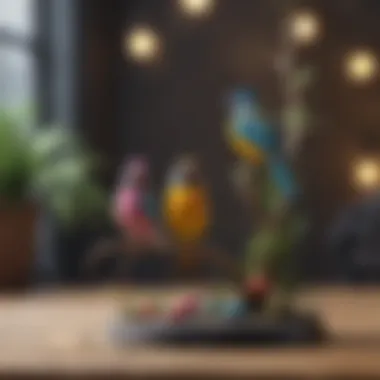
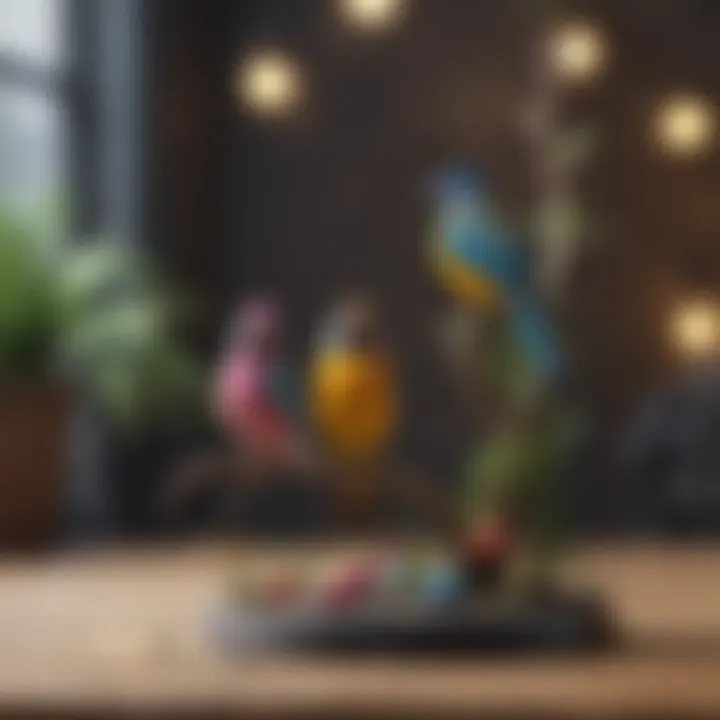
Manzanita Perches
Manzanita perches are another excellent choice for bird owners. Made from manzanita wood, these perches are both sturdy and visually appealing. Beyond aesthetics, they offer a smooth, durable surface that many birds find comfortable. Due to their strength, manzanita perches are particularly suitable for larger birds that require more stable support.
Additionally, manzanita does not splinter easily, making it a safer option. It is a naturally resistant wood, which means it is often free of pests or insects. However, the cost of manzanita perches can be higher than other types. Therefore, investing in a durable manzanita perch may pay off in the long run, as they often outlast other materials.
Plastic Perches
Plastic perches come in various shapes and colors, which can be visually engaging for birds. They are lightweight and easy to clean, making them a convenient choice for bird owners. Furthermore, they often come in different thicknesses and textures, which can help mimic the range of environments birds might experience.
However, there are drawbacks to consider. Plastic can become slippery, especially when wet, and some birds may not prefer their feel compared to natural wood. Additionally, certain plastics can be harmful if chewed on, so selecting bird-safe materials is crucial. Regular inspection for wear and tear is important to ensure the safety of your bird.
Sandpaper Perches
Sandpaper perches offer a unique advantage concerning foot health. These perches feature a layer of sandpaper wrapped around a durable core, which can help to naturally wear down a bird's nails as they perch. This can be particularly beneficial for birds that do not wear down their nails through other means. Maintaining appropriate nail length is important for comfort and mobility.
However, sandpaper perches can cause discomfort if the grit is too coarse or if used for extended periods. It should not be the only type of perch in the cage, but rather a supplementary option alongside softer, natural perches. Balance is key in providing your birds a comfortable and healthy environment.
Important: When choosing perches, regularly assess each type's impact on your bird’s claws and overall comfort to ensure their well-being and to promote a balanced lifestyle.
Selecting the Right Perch
Selecting the right perch for a bird is more than just a matter of preference; it plays a vital role in ensuring the well-being of avian companions. Birds are naturally inclined to perch as it is an instinctual behavior, crucial for their comfort and health. An appropriate perch can enhance their quality of life by providing physical support, promoting exercise, and allowing them to engage their innate behaviors. Understanding which elements to consider when choosing a perch helps create a supportive environment for your pet.
Bird Species Considerations
When selecting a perch, it's important to consider the specific needs of the bird species you own. A parrot, for example, may require broader perches than a finch. Different species have varying preferences for diameter and texture, all influenced by their natural habitats. For instance, larger birds like African grey parrots benefit from thicker, sturdier perches that allow for grip and tail support. In contrast, smaller birds may prefer perches that are narrower and easier to maneuver. Additionally, each species has its own unique behaviors, which can affect perch preferences.
Before making a purchase, research the specific needs of your bird species for better choice in perches.
Diameter and Textures
Perch diameter is crucial for a bird's foot health. A perch that is too thin may lead to foot problems, while one that is too thick can make it difficult for the bird to grip. The ideal diameter should allow the bird to wrap its toes comfortably around the perch. Recommended sizes vary; for example, perches for small birds should be between one-quarter to one-half inch in diameter, while larger birds may need perches measuring one-inch or more.
Texture also influences perch selection. Natural wood perches are often favored due to their irregular surfaces, which promote healthy foot exercise and prevent boredom. Rough textures can offer better grip, whereas smooth perches might lead to slipping. Mixing various textures can enrich your bird's environment and encourage exploration, enhancing their well-being.
Location of Perches and Stands
The placement of perches and stands is crucial in a bird's habitat. They should be positioned at different heights to mimic the tree canopies found in their natural environment. This setup allows birds to choose their preferred vantage point, which can reduce stress and encourage natural behaviors. Additionally, it is advisable to keep perches away from drafts and direct sunlight to prevent discomfort
Consider the proximity of perches to feeding stations and water sources. Birds often prefer to have food and shelter nearby. Therefore, adequate spacing between perches and feeding stands ensures that your bird feels safe while navigating its environment. In case of multiple birds, ensure that perches are evenly spaced to reduce territorial disputes.
Benefits of Well-Designed Perches
Bird perches are not just functional elements in a bird's habitat. They play a key role in ensuring the physical and mental well-being of pet birds. The concept of well-designed perches encompasses several factors, including material, shape, and placement. Each element contributes significantly to the overall health of the bird. This section discusses various elements related to the benefits of well-designed perches, allowing pet owners to appreciate their importance fully.
Physical Health
Well-designed perches positively impact the physical health of birds in multiple ways. First, they promote foot health. Birds have different foot structures which require varied perch sizes and textures. A perch that mimics natural environments can help prevent issues like foot sores and arthritis. Soft, uneven surfaces, for example, encourage the foot muscles to exercise naturally, reducing the risk of atrophy.
Additionally, the placement of perches can influence a bird's posture. Birds that stand at a natural angle are less likely to develop musculoskeletal issues. Properly designed perches also allow for easy navigation, enabling birds to move and exercise comfortably within their space.
Mental Stimulation
Cognitive health in birds is as crucial as their physical health. Well-designed perches contribute significantly to mental stimulation. Birds are naturally curious and need environments that challenge their minds. By providing a variety of perch types and heights, you stimulate exploration and problem-solving skills.
Some owners choose to incorporate perches into interactive setups, such as attaching toys or treats to them. This combination heightens the mental engagement of the birds, preventing boredom and associated behavioral problems. It is important to frequently change the configuration to maintain interest and encourage new behaviors.
Behavioral Improvement
The design of a bird's perch can greatly influence its behavior. When birds feel secure and comfortable on their perches, they display more favorable behaviors. They are less likely to engage in stress-related issues, such as feather plucking or excessive vocalization.
Moreover, a well-structured environment fosters social interactions among birds. Birds can safely perch while observing each other, which is critical for species that are social in nature. Having designated areas to perch can also help in establishing routines and reducing territorial disputes, creating a harmonious living space.
"Perches significantly contribute to the overall happiness of a pet bird, affecting both its physical and mental health."
In summary, well-designed perches play an essential role in a pet bird's life. They ensure healthy feet, encourage exploration, and foster good behaviors. By understanding these benefits, pet owners can provide better habitats for their avian companions.
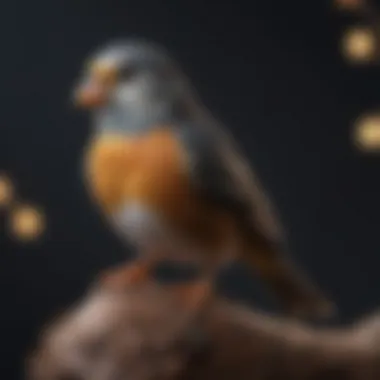
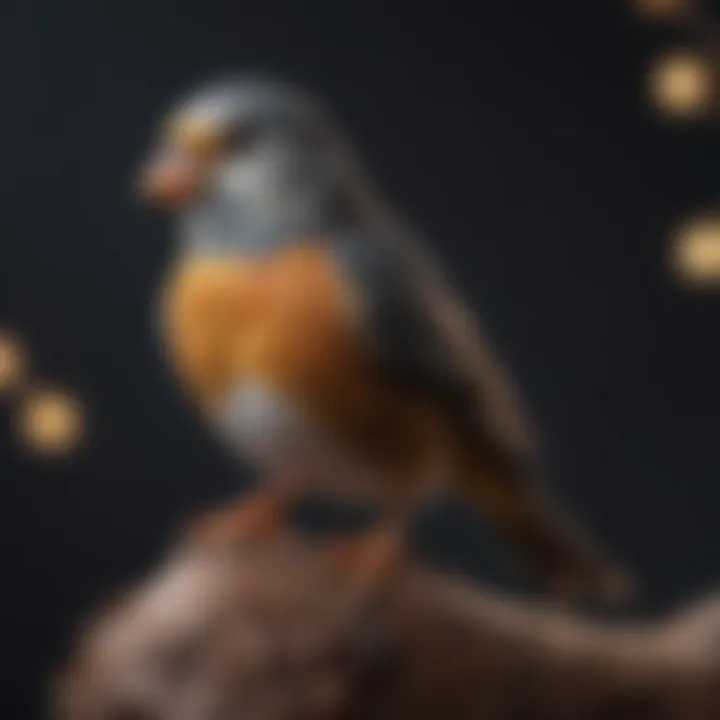
Maintenance of Bird Stands and Perches
Maintaining bird stands and perches is critical for the overall well-being of pet birds. Regular upkeep ensures the safety of the birds while also contributing positively to their health and happiness. The physical environment plays a big role in how birds behave and thrive. Therefore, understanding maintenance is not just about cleanliness; it also involves recognizing signs of wear, ensuring durability, and adapting to the specific needs of various bird species.
Cleaning Practices
Regular cleaning of stands and perches is essential. Birds can be prone to various diseases, some of which can stem from unsanitary living conditions. Here are several practices to ensure cleanliness:
- Daily Spot Cleaning: Remove droppings and food residues each day. This minimizes the growth of harmful bacteria and fungi.
- Weekly Deep Cleaning: Remove the stands and perches from the bird's habitat. Use mild soap and water to scrub surfaces. Avoid harsh chemicals that could harm the birds. Rinse thoroughly and let dry completely before reintroducing.
- Choose Safe Cleaning Products: Natural or bird-safe cleaning agents are preferable. Products like vinegar or baking soda can effectively clean while posing little risk to birds.
- Disinfecting: Once a month, consider disinfecting the surfaces to further protect against pathogens. Ensure proper rinsing to prevent any residue from remaining on the surfaces.
By keeping perches and stands clean, owners can create a healthier environment that reduces the likelihood of infections and diseases.
Inspecting for Wear and Tear
Inspection of bird stands and perches should not be overlooked. Over time, wear and tear can affect the safety and function of these accessories. Here are some benchmarks for effective inspection:
- Check for Splinters: Particularly for natural wood perches, splinters can lead to injuries. If splinters are found, it may be necessary to sand down rough areas or replace the perch.
- Assess Stability: Ensure that the stands are stable and secure. Wobbly stands can cause injury and distress to birds, making it important to test them regularly.
- Look for Fading: Materials like plastic can fade with sunlight exposure. This can compromise the structural integrity of the stand or perch.
- Signs of Chewing or Biting: Birds often chew on their perches. While this behavior is natural, excessive damage may require replacement to avoid hazards.
By routinely inspecting the equipment, bird owners can prevent unforeseen accidents and ensure that their pets always have access to safe, functional, and suitable environments.
Common Mistakes to Avoid
When it comes to providing the best environment for your birds, awareness of common pitfalls is crucial. Many owners overlook the significance of specific elements that contribute to the overall health and happiness of their avian companions. This section aims to highlight these vital mistakes, enabling you to create a more enriching habitat.
Inadequate Perch Variety
One of the primary errors bird owners make is not offering a sufficient variety of perches. Birds thrive when they have options to choose from. Each perch can serve unique purposes based on texture, diameter, and material. For example, a hard surface can be beneficial for their nails, while softer ones might offer comfort.
When selecting perches, consider these factors:
- Materials: Different wood types, plastic, and sandpaper can cater to varying needs of birds.
- Shapes: Round, flat, or textured surfaces encourage natural behaviors and stimulate foot health.
- Sizes: Perches should come in various diameters to accommodate different species effectively.
Also, remember to change the location of the perches from time to time. This variation mimics natural settings and encourages exploration.
Ignoring Bird Preferences
Birds can display strong preferences for certain types of perches. Picking perches based solely on aesthetics or convenience can lead to drawbacks. Each bird species may have individual likes and dislikes.
To avoid ignoring these preferences, observe your bird's behavior closely. Are they spending most of their time on a particular perch? Or do they shy away from a certain type? Here are suggestions to keep in mind:
- Observation: Take time to watch how your bird interacts with the perches available. This insight can greatly influence your future choices in perch design.
- Testing: Introduce new perch options gradually. This will help you gauge what captures your bird's interest and which is less appealing.
- Consulting Resources: Utilize community resources, such as reddit.com or relevant bird care books, to learn about common preferences in similar bird species.
Understanding your bird's unique preferences is essential for their comfort and well-being. When birds feel comfortable on their perches, they exhibit positive behaviors.
Ending: Creating a Optimal Environment
In the realm of avian care, establishing an optimal environment is crucial for the well-being of birds. Bird stands and perches serve not only as mere accessories but as fundamental elements that shape the physical and psychological state of our feathered companions. The thoughtful integration of these items enhances a bird’s life, fostering both health and happiness.
Integrating stands and perches into daily life requires an understanding of the birds’ natural behaviors. Birds are naturally inclined to perch, climb, and explore; therefore, providing various perches mimics their natural habitat. Careful selection of perch materials and designs can lead to healthier feet and better overall well-being.
A well-designed environment reduces stress and promotes physical activity. It encourages exploration, which keeps birds mentally stimulated. Additional elements such as toys or feeding stations can complement the perches and stands, creating an engaging space.
Every aspect of a bird's environment contributes to its quality of life, making it essential for owners to prioritize effective designs.
Addressing specific considerations such as perch height, spacing and shape can significantly affect a bird's comfort and enjoyment. Likewise, mindful placement of stands ensures that birds feel secure in their surroundings. Integrating a variety of perches can meet different needs and preferences, allowing birds to express natural behaviors.
Integrating Stands and Perches in Daily Life
To fully leverage the benefits of bird stands and perches, one must integrate them seamlessly into everyday routines. First, assess the bird’s personality and species requirements. This assessment will guide you in selecting the appropriate types of perches and stands.
Consider placing the bird's stand in a central location where it can observe family activities. Exposure to daily life instills a sense of security and belonging for the bird. Ensure to rotate and rearrange the perches and toys periodically. This keeps the environment fresh and stimulating for the bird.
Equally important is the regular cleaning of the perches and stands. Hygiene not only prevents disease but also maintains an appealing environment. Use safe, bird-friendly cleaning products to maintain the integrity of these accessories.
Future Trends in Bird Care Accessories
The landscape of bird care is evolving. Emerging trends in bird care accessories are increasingly focused on sustainability and technology. Products made from eco-friendly materials are becoming prominent, addressing environmental concerns while ensuring the safety of birds.
Technological advancements are also influencing bird accessory designs. For example, some companies are introducing smart bird stands equipped with features like temperature regulation and built-in feeding mechanisms.
In addition, customization is becoming a trend. Bird owners can select stands and perches tailored to specific bird species, enhancing comfort and enjoyment. This personalization speaks directly to the growing understanding of avian behaviors and needs.
Ultimately, it is vital for pet owners to stay informed about new developments in bird care. By doing so, they can continually adapt their approaches and provide the best possible environments for their birds.







